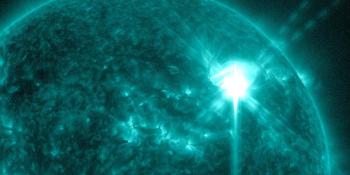Affichage des archives de samedi, 30 août 2003
Rapport d'activité solaire
Any mentioned solar flare in this report has a scaling factor applied by the Space Weather Prediction Center (SWPC). Because of the SWPC scaling factor, solar flares are reported as 42% smaller than for the science quality data. The scaling factor has been removed from our archived solar flare data to reflect the true physical units.
Rapport d'activité solaire et géophysique 2003 Aug 30 2200 UTCFait par le NOAA © SWPC et adapté par SpaceWeatherLive.com
Rapport de l'USAF/NOAA sur l'activité solaire et géophysique
SDF numéro 242 publié à 2200Z le 30 Aug 2003IA. Analyse des régions solaires actives et activité du 29-2100Z au 30-2100Z Solar activity has been low. Though several regions
continue to reside on the solar disk, none have demonstrated a
strong level of activity. A solar filament (near S12W27, 17 deg
extent) collapsed at 2022 UTC, but no material appears to have been
ejected from the sun.
IB. Prévisions d'activité solaire
Solar activity is expected to be low.
None of the current active regions shows any signs of greater than
low potential for flare activity.
IIA. Résumé de l'activité géophysique du 29-2100Z au 30-2100Z
The geomagnetic field has been at active to minor storm levels with a
single period of major storming at 0600 UTC. The interplanetary
magnetic field continues to be oriented southward, and the solar
wind speeds continue to be elevated well above 450 km/s. During the
storm period, wind speeds were near 650 km/s. There is some
evidence in the energetic protons measured at the L1 orbit that a
small interplanetary shock passed at or near the major storming
period. The greater the 2 MeV electron flux at geosynchronous orbit
reached high levels today.
IIB. Prévision de l'activité géophysique
The geomagnetic field is
expected to be at unsettled to minor storm levels for the next 24 to
36 hours. Near the end of the second day, a co-rotating interaction
region associated with a coronal hole should effect minor to major
storm levels, and continue as a high speed stream for the remainder
of the forecast period.
III. Probabilité d'éruption solaire du 31 Aug au 02 Sep
| Classe M | 15% | 15% | 15% |
| Classe X | 01% | 01% | 01% |
| Proton | 01% | 01% | 01% |
| PCAF | Green | ||
IV. Flux Penticton 10.7 cm
Observé 30 Aug 114 Prévisionnel 31 Aug-02 Sep 115/115/115 Moyenne des 90 derniers jours 30 Aug 127
V. Indice géomagnetique A
Observé Afr/Ap 29 Aug 012/015 Estimé Afr/Ap 30 Aug 015/018 Prévisionnel Afr/Ap 31 Aug-02 Sep 012/012-020/020-025/025
VI. Probabilités d'activité géomagnétique du 31 Aug au 02 Sep
| A. Latitudes moyennes | |||
|---|---|---|---|
| Actif | 35% | 30% | 30% |
| Tempête mineure | 20% | 25% | 25% |
| Tempête majeure/sévère | 05% | 15% | 15% |
| B. Hautes latitudes | |||
|---|---|---|---|
| Actif | 35% | 35% | 35% |
| Tempête mineure | 20% | 30% | 30% |
| Tempête majeure/sévère | 05% | 15% | 25% |
Dernières nouvelles
Forum
AR3664 53Latest SC25 Predictions 122Incoming Active Regions 233AR3663 237CME Imagery isn't updating since May 3rd. 10
Plus de messages du forumAidez SpaceWeatherLive.com !
Vous êtes de plus en plus nombreux à consulter SpaceWeatherLive pour suivre l'activité solaire ou aurorale, et avec le traffic les coûts du serveur augmentent. Si vous appréciez SpaceWeatherLive, soutenez notre projet en faisant un don afin que nous puissions continuer à vous informer !

La Météo Spatiale en faits
| Dernière classe X | 06/05/2024 | X4.4 |
| Dernière classe M | 07/05/2024 | M2.6 |
| Dernier orage géomagnétique | 06/05/2024 | Kp5 (G1) |
| Jours sans taches solaires | |
|---|---|
| Dernier jour sans taches solaires | 08/06/2022 |
| Nombre mensuel moyen de taches solaires | |
|---|---|
| avril 2024 | 136.5 +31.6 |
| Last 30 days | 159 +66.6 |


